|
Size: 4736
Comment:
|
Size: 11272
Comment:
|
| Deletions are marked like this. | Additions are marked like this. |
| Line 6: | Line 6: |
| <<TableOfContents(2,2)>> |
|
| Line 7: | Line 9: |
| This tutorial is based on resting-state recordings for 7 subjects with two conditions: eyes open (YO), eyes closed (YF). We have recorded 20 runs of 15 seconds for each subject and each condition, . | This tutorial is based on resting-state recordings for 7 subjects with two conditions: eyes open (YO), eyes closed (YF). We have recorded 20 runs of 15 seconds for each subject and each condition. |
| Line 11: | Line 13: |
| * Start by downloading the tutorial dataset: *file.zip*. * The file is an exported Brainstorm protocol. To load in your database, use the menu:<<BR>> File > Load Protocol > '''Load from zip file'''. <<BR>><<BR>> {{attachment:LoadProtocol.png||height="279",width="392"}} |
* Start by downloading the tutorial dataset '''TutorialDba.zip''' from the [[http://neuroimage.usc.edu/bst/download.php|Download]] page. * The file is an exported Brainstorm protocol. To load it in your database, use the menu:<<BR>> File > Load Protocol > '''Load from zip file'''. <<BR>><<BR>> {{attachment:loadzip.gif}} |
| Line 18: | Line 19: |
| * Double-click on "aseg atlas" (which contains the subcortical structures) * Select the amygdala, the thalamus and the hippocampus, and create a subatlas * Merge the cortex with the atlas of selected structures ; rename the structure created in CortexDBA * Create a new atlas "Source Model Atlas", and set modeling options to "Deep brain" |
* Right-click on "aseg atlas" > '''Less vertices''' > '''15000''' vertices. <<BR>><<BR>> {{attachment:aseg_downsample.gif||height="213",width="436"}} * Double-click on "aseg atlas_15000V" (contains the subcortical structures from the FreeSurfer altas). |
| Line 23: | Line 22: |
| {{attachment:SelectStructures.png}} {{attachment:MergeSurfaces.png}} {{attachment:RenameCtx.png}} {{attachment:SourceModelOptions.png}} {{attachment:SetModelingOptions.png}} | * Select the amygdala, the thalamus and the hippocampus, and create a subatlas. <<BR>><<BR>> {{attachment:aseg_keep.gif||height="385",width="555"}} |
| Line 25: | Line 24: |
| == Compute source activity == Then, compute a headmodel for each subject as "Custom Source Model" ; it is advised to run it as batch from the pipeline editor. |
* '''Merge '''the cortex with the selected structures. '''Rename '''the new surface in "cortex_mixed". <<BR>><<BR>> {{attachment:aseg_merge.gif}} {{attachment:aseg_rename.gif}} |
| Line 28: | Line 26: |
| {{attachment:HeadModelBatch.png}} {{attachment:HeadModelOptions.png}} | * Open the cortex_mixed surface and create a new atlas "'''Source model options'''". With Matlab 2015b+, the display looks weird because it limits the number of possible transparent layers to 5. To produce nicer figures, disable the OpenGL renderer (File > Edit preferences). The display will be much slower, but the renderer won't suffer from this limitation.<<BR>><<BR>> {{attachment:atlas_model.gif||height="214",width="668"}} |
| Line 30: | Line 28: |
| At this stage, it is now possible to compute sources. | * Set the set modeling options to "'''Deep brain'''" for all the structures.<<BR>><<BR>> {{attachment:atlas_dba.gif||height="246",width="606"}} |
| Line 32: | Line 30: |
| {{attachment:ComputeSources.png}} {{attachment:SourceOptions.png}} {{attachment:SourceOptions2.png}} | * It will automatically set the orientation constraint to "constrained" for the cortex and hippocampus regions, and "unconstrained" for all the other regions. <<BR>><<BR>> {{attachment:atlas_dba2.gif}} |
| Line 34: | Line 32: |
| You can now visualize activity the same way as for usual headmodels. | == Location and orientation constraints == Two types of constraints can be applied to each anatomical region in the atlas "Source model": |
| Line 36: | Line 35: |
| {{attachment:VisuActivity.png}} | * '''Location constraint''': Defines where the sources corresponding to these regions are placed. * '''Surface''': The sources are located on the surface of the structure (cortex and hippocampus). The surface describing the region is directly used as the source space. * '''Volume''': The sources are located inside the volume of the region. The source space is a grid of points uniformly distributed inside of the volume delimited by the syrface of the structure. * '''Deep brain''': Use the preferred configuration defined in the Deep Brain Atlas (surface for the cerebral cortex and hippocampus, volume for all the other structures). * '''Orientation constraint''': * '''Constrained''': Defines only one dipole per grid point, with a fixed orientation orientation. * With option "Surface": Uses the normal orientation to the surface at each point. * With option "Deep brain": Uses the preferred orientation defined in the atlas (see below). * '''Unconstrained''': Uses three orthogonal dipoles per grid point (x,y,z). * '''Loose''': Intermediate option, uses three orthogonal dipoles per grid point, but favors the preferred orientation used for the contrained case. |
| Line 38: | Line 46: |
| If the activity of the volume structures (thalamus and amygdala here) do not appear, try moving the Min size cursor to max and then back to 1. | Based on the anatomical observations reported for each subcortical region in the reference articles (next section), the preferred combination of constraints is described below. The reference articles also estimate the number of averaged trials needed to detect responses in some regions. || ||'''Location<<BR>>constraint''' ||'''Preferred<<BR>>orientation''' ||'''Default orientation <<BR>>constraint''' ||'''Trials (MEG)''' ||'''Trials (EEG)''' || ||'''Cortex''' ||Surface ||Normal ||Constrained ||- ||- || ||'''Hippocampus''' ||Surface ||Normal ||Constrained ||21 ||45 || ||'''Cerebellum''' ||Surface ||Normal ||Unconstrained ||- ||- || ||'''Accumbens''' ||Volume ||None ||Unconstrained ||- ||- || ||'''Amygdala''' ||Volume ||None ||Unconstrained ||- ||- || ||'''Brainstem''' ||Volume ||None ||Unconstrained ||400 (LGN) ||490 (LGN) || ||'''Caudate''' ||Volume ||None ||Unconstrained ||- ||- || ||'''Putamen''' ||Volume ||None ||Unconstrained ||34 ||23 || ||'''Pallidum''' ||Volume ||Y axis ||Constrained ||> 10000 ||> 10000 || ||'''Thalamus''' ||Volume ||None ||Unconstrained ||3500 ||3700 || == Source estimation [TODO] == ==== Head model ==== * Select all the subjects (except for the empty room recordings) > right-click > '''Compute head model'''. Select "'''Custom source model'''", and leave the other options to their defaults. <<BR>><<BR>> {{attachment:dba_headmodel.gif||height="244",width="443"}} * You can explore the source grids that were computed. Right-click on one of the head models > '''Check source grid (volume)''' and '''Check source grid (surface)'''. In the Scout tab, select the atlas "User scouts" to get a clearer view. In panel Surface, increase the transparency of the surface to see the source grids representing the select subcortical regions. <<BR>><<BR>> {{attachment:headmodel_grid.gif||height="198",width="665"}} ==== Inverse model ==== * The noise covariance matrix was estimated from the empty room recordings (Empty_Subject) and copied to all the folders of all the subjects. * Select all the subjects (except the empty room recordings), right-click > '''Compute sources'''. <<BR>>Select '''Minimum norm (wMNE)''' and lelave the other options to their default values. <<BR>><<BR>> {{attachment:dba_inverse.gif||height="235",width="446"}} * Double-click on the sources for any trial (segment of 15s of rest recordings). Make sure the atlas "'''User scouts'''" is selected in the Scout tab, then explore the display options available in the Surface tab. The surface regions (cortex and hippocampus) are represented as surfaces, and the values are directly mapped on the surface. The volume regions (amygdala and thalamus) are represented as grids of dots. <<BR>><<BR>> {{attachment:dba_display.gif||height="244",width="647"}} * In the Scout tab, you can use the atlas "'''Source model'''" to display separately some regions difficult to observe with all the cortex. Typically the activity on the hippocampus surface. Click on the button [SEL] to display only the selected regions, then select the hippocampus entries. [TODO] |
| Line 41: | Line 74: |
| Now that the source calculations are done, we design a statistical analysis to assess the eyes-open and eyes-closed contrast. | We will now design a statistical analysis to assess the eyes-open and eyes-closed contrast. As a reminder, the recordings available in the database have already been filtered in the alpha frequency band (7-13Hz). As a measure of the global of the activity in this frequency band, we will average all the time samples in each block of 15s. Note that this is not the recommended procedure anymore: it would have been better to simply compute a PSD from the sources estimated for the continuous file link, but this option was not available at the time this tutorial was written. |
| Line 43: | Line 76: |
| * First, the alpha-power is time-averaged for each run<<BR>> {{attachment:AverageTime.png}} {{attachment:AverageTimeOptions3.png}} | * In Process1, select all the subjects (except for Empty_Subject)and select '''[Process sources]'''. * Run process Average > '''Average time''' > Use absolute value, All file. <<BR>><<BR>> {{attachment:dba_avgtime.gif||height="280",width="435"}} * The option '''Use absolute values of source activations''' also "flattened" the source maps. The regions that had a few regions with "unconstrained" source orientations, with three values per grid point. These three orientations were grouped into one value by taking the norm along the three axes: sqrt(x^2^+y^2^+z^2^). * In Process2, select FilesA=Subject74/YF (eyes closed) and FilesB=Subject74/YO (eyes open). Then enter "avg" in the Filter box, to select only the time averages. You should have 20 files selected on each side. * Run the process '''Test > Permutation test (independent)''', as configured as below: <<BR>><<BR>>{{attachment:dba_test.gif}} |
| Line 45: | Line 82: |
| * Then, the "Process2" tab is used : place the source power files of the eyes-closed condition in the "Files A" space and of the eyes-open condition in the "Files B" space.<<BR>>To gain time, it is possible to sort the functional data by conditions, place the subjects in "FilesA" and "FilesB" and use the filter to include only files that contain 'avg' (for time-averaged files) * Run a Student's T-Test to compute a statistical contrast between the conditions<<BR>> {{attachment:Ttest.png}} {{attachment:TtestOptions.png}} * The stat file can then be visualized and the values corresponding to subcortical structures are also appearing<<BR>> {{attachment:VisuStat.png}} * It is also interesting to observe the difference of means between conditions. To compute this, instead of runnning a Student's T-Test, select the "Difference of means" option<<BR>> {{attachment:DiffOfMeans.png}} |
* The statistical result can be displayed similarly to the source files, and you can edit the statistical threshold in the Stat tab. Red values indicate that the power in the alpha band is significantly higher in condition YF (eyes closed). As expected, that parieto-occipital regions appear clearly in this contrast.<<BR>><<BR>> {{attachment:dba_test2.gif}} |
| Line 50: | Line 84: |
| == Volume scouts == Some subcortical structures are modeled as volume source structures (for instance here, the thalamus and the amygdala). It is not possible to display scouts time series for these structures from the "Source model" or "Structures" atlases. It is necessary to create a new atlas, specific to volumic scouts. The steps are the following : |
== Volume scouts [TODO] == Some subcortical structures are modeled as volume source structures (for instance here, the thalamus and the amygdala). It is not possible to display scouts time series for these structures from the "Source model" or "Structures" atlases. It is necessary to create a new atlas, specific to volume scouts. The steps are the following : |
| Line 53: | Line 87: |
| * First, create the volumic atlas<<BR>> {{attachment:VolumeScouts.png}} | * First, create the volume atlas<<BR>><<BR>> {{attachment:DBA_VolumeScouts.png||height="264",width="668"}} |
| Line 55: | Line 90: |
| * Click on the "Create scout" cross, and click one point of the structure you want to include in the scout<<BR>> {{attachment:VolumeFirstPoint.png}} * Click on the "Increase scout size" as many times as necessary to include all the points of the volume, for example in the right thalamus<<BR>> {{attachment:IncreaseScoutSize.png}} {{attachment:RightThal.png}} * Rename the scout and set the correct region and the desired function<<BR>> {{attachment:RenameScout.png}} {{attachment:SetRegion.png}} {{attachment:SetFunction.png}} * Repeat this operation for all the volumic scouts you want to create * Finally, you can display time series of your choice<<BR>> {{attachment:DisplayScoutsTS.png}} |
* Click on the "Create scout" cross, and click one point of the structure you want to include in the scout<<BR>> {{attachment:DBA_VolumeScout_FirstPoint.png||height="291",width="659"}} * Click on the "Increase scout size" as many times as necessary to include all the points of the volume, for example in the right thalamus<<BR>> {{attachment:DBA_IncreaseScoutSize2.png||height="239",width="148"}} {{attachment:DBA_Scout_RightThal.png||height="272",width="266"}} * Rename the scout and set the correct region and the desired function<<BR>><<BR>> {{attachment:DBA_RenameScout.png||height="78",width="192"}} {{attachment:DBA_SetRegion2.png||height="271",width="260"}} {{attachment:DBA_SetFunction2.png||height="270",width="244"}} * Repeat this operation for all the volume scouts you want to create * Finally, you can display time series of your choice<<BR>><<BR>> {{attachment:DBA_DispolayScoutsTS.png||height="306",width="280"}} == References == Attal Y, Bhattacharjee M, Yelnik J, Cottereau B, Lefèvre J, Okada Y, Bardinet E, Chupin M, Baillet S (2009)<<BR>>[[http://www.ncbi.nlm.nih.gov/pubmed/18003114|Modelling and detecting deep brain activity with MEG and EEG]]<<BR>>'''IRBM''', 30(3):133-138 Attal Y, Schwartz D (2013)<<BR>>[[http://www.plosone.org/article/info:doi/10.1371/journal.pone.0059856|Assessment of Subcortical Source Localization Using Deep Brain Activity Imaging Model with Minimum Norm Operators: A MEG Study]]<<BR>>'''PLOS ONE''', 8(3):e59856 Dumas T, Dubal S, Attal Y, Chupin M, Jouvent R (2013)<<BR>>[[http://www.plosone.org/article/info:doi/10.1371/journal.pone.0074145|MEG Evidence for Dynamic Amygdala Modulations by Gaze and Facial Emotions]]<<BR>>'''PLOS ONE''', 8(9): e74145 |
DBA tutorial: Compute sources in deep cerebral structures
Authors: Jean-Eudes Le Douget, Francois Tadel, Denis Schwartz
This tutorial explains step-by-step how to use the DBA (Deep Brain Activity) functionality, useful to assess subcortical source localization.
Contents
Import database
This tutorial is based on resting-state recordings for 7 subjects with two conditions: eyes open (YO), eyes closed (YF). We have recorded 20 runs of 15 seconds for each subject and each condition.
The goal is to compute the contrast between the two conditions in the alpha band. The data has already been filtered in the alpha frequency band (7-13Hz) and the default anatomy is used for all the subjects.
Start by downloading the tutorial dataset TutorialDba.zip from the Download page.
The file is an exported Brainstorm protocol. To load it in your database, use the menu:
File > Load Protocol > Load from zip file.
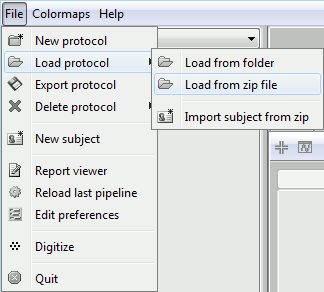
Select deep structures
The first step consists in creating the surface file that includes the cortex and the deep structures that we want to include in the model. Here, in the default anatomy:
Right-click on "aseg atlas" > Less vertices > 15000 vertices.
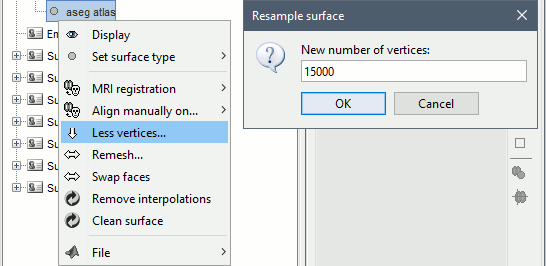
Double-click on "aseg atlas_15000V" (contains the subcortical structures from the FreeSurfer altas).
Select the amygdala, the thalamus and the hippocampus, and create a subatlas.
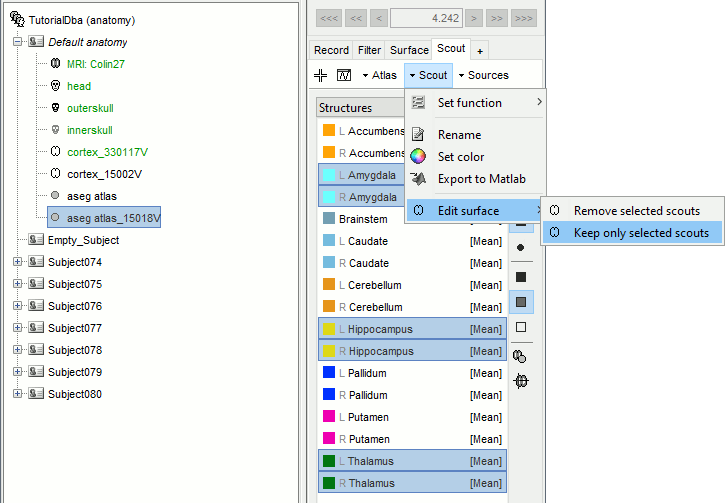
Merge the cortex with the selected structures. Rename the new surface in "cortex_mixed".
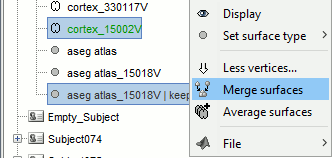
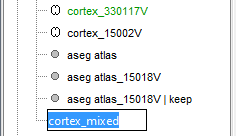
Open the cortex_mixed surface and create a new atlas "Source model options". With Matlab 2015b+, the display looks weird because it limits the number of possible transparent layers to 5. To produce nicer figures, disable the OpenGL renderer (File > Edit preferences). The display will be much slower, but the renderer won't suffer from this limitation.

Set the set modeling options to "Deep brain" for all the structures.
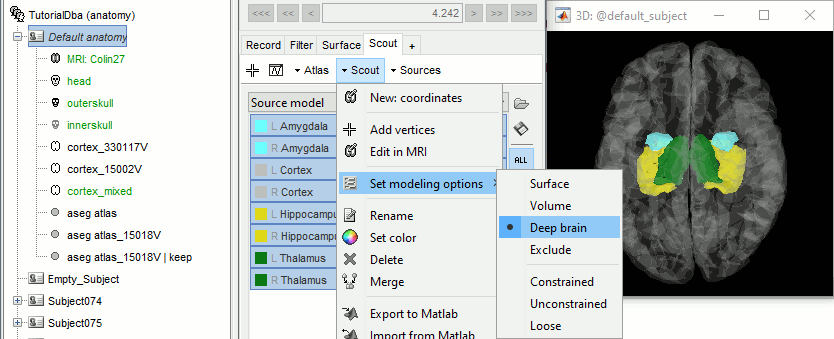
It will automatically set the orientation constraint to "constrained" for the cortex and hippocampus regions, and "unconstrained" for all the other regions.
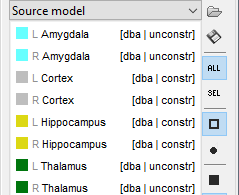
Location and orientation constraints
Two types of constraints can be applied to each anatomical region in the atlas "Source model":
Location constraint: Defines where the sources corresponding to these regions are placed.
Surface: The sources are located on the surface of the structure (cortex and hippocampus). The surface describing the region is directly used as the source space.
Volume: The sources are located inside the volume of the region. The source space is a grid of points uniformly distributed inside of the volume delimited by the syrface of the structure.
Deep brain: Use the preferred configuration defined in the Deep Brain Atlas (surface for the cerebral cortex and hippocampus, volume for all the other structures).
Orientation constraint:
Constrained: Defines only one dipole per grid point, with a fixed orientation orientation.
- With option "Surface": Uses the normal orientation to the surface at each point.
- With option "Deep brain": Uses the preferred orientation defined in the atlas (see below).
Unconstrained: Uses three orthogonal dipoles per grid point (x,y,z).
Loose: Intermediate option, uses three orthogonal dipoles per grid point, but favors the preferred orientation used for the contrained case.
Based on the anatomical observations reported for each subcortical region in the reference articles (next section), the preferred combination of constraints is described below. The reference articles also estimate the number of averaged trials needed to detect responses in some regions.
Location
constraintPreferred
orientationDefault orientation
constraintTrials (MEG)
Trials (EEG)
Cortex
Surface
Normal
Constrained
-
-
Hippocampus
Surface
Normal
Constrained
21
45
Cerebellum
Surface
Normal
Unconstrained
-
-
Accumbens
Volume
None
Unconstrained
-
-
Amygdala
Volume
None
Unconstrained
-
-
Brainstem
Volume
None
Unconstrained
400 (LGN)
490 (LGN)
Caudate
Volume
None
Unconstrained
-
-
Putamen
Volume
None
Unconstrained
34
23
Pallidum
Volume
Y axis
Constrained
> 10000
> 10000
Thalamus
Volume
None
Unconstrained
3500
3700
Source estimation [TODO]
Head model
Select all the subjects (except for the empty room recordings) > right-click > Compute head model. Select "Custom source model", and leave the other options to their defaults.
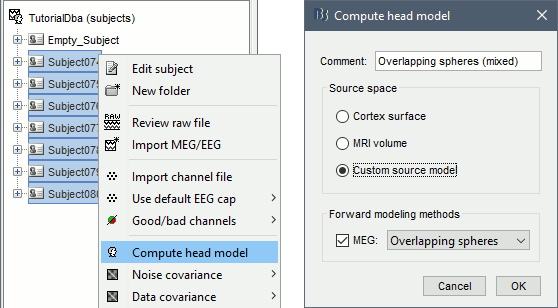
You can explore the source grids that were computed. Right-click on one of the head models > Check source grid (volume) and Check source grid (surface). In the Scout tab, select the atlas "User scouts" to get a clearer view. In panel Surface, increase the transparency of the surface to see the source grids representing the select subcortical regions.

Inverse model
- The noise covariance matrix was estimated from the empty room recordings (Empty_Subject) and copied to all the folders of all the subjects.
Select all the subjects (except the empty room recordings), right-click > Compute sources.
Select Minimum norm (wMNE) and lelave the other options to their default values.
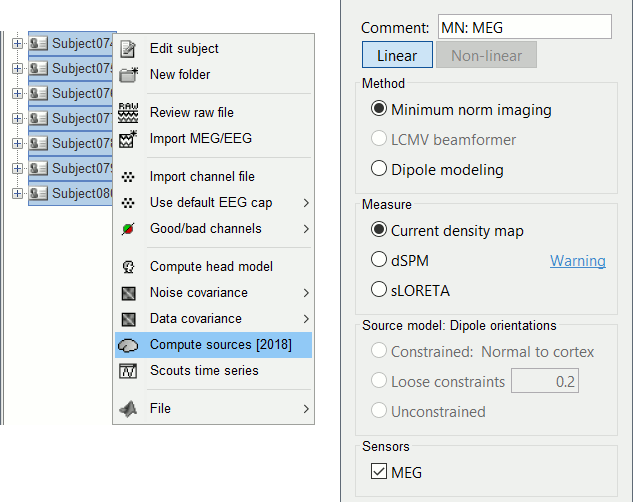
Double-click on the sources for any trial (segment of 15s of rest recordings). Make sure the atlas "User scouts" is selected in the Scout tab, then explore the display options available in the Surface tab. The surface regions (cortex and hippocampus) are represented as surfaces, and the values are directly mapped on the surface. The volume regions (amygdala and thalamus) are represented as grids of dots.
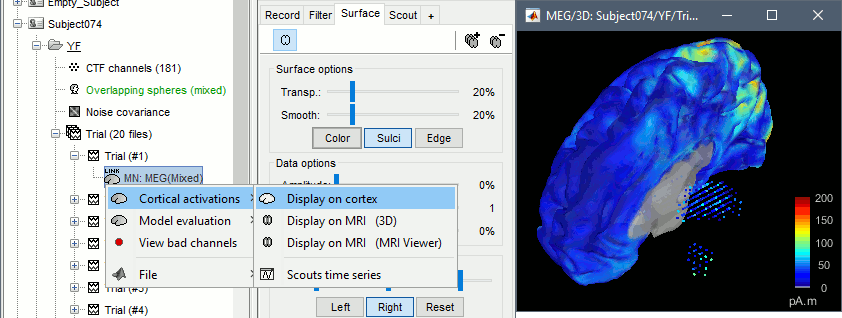
In the Scout tab, you can use the atlas "Source model" to display separately some regions difficult to observe with all the cortex. Typically the activity on the hippocampus surface. Click on the button [SEL] to display only the selected regions, then select the hippocampus entries. [TODO]
Compute statistics
We will now design a statistical analysis to assess the eyes-open and eyes-closed contrast. As a reminder, the recordings available in the database have already been filtered in the alpha frequency band (7-13Hz). As a measure of the global of the activity in this frequency band, we will average all the time samples in each block of 15s. Note that this is not the recommended procedure anymore: it would have been better to simply compute a PSD from the sources estimated for the continuous file link, but this option was not available at the time this tutorial was written.
In Process1, select all the subjects (except for Empty_Subject)and select [Process sources].
Run process Average > Average time > Use absolute value, All file.
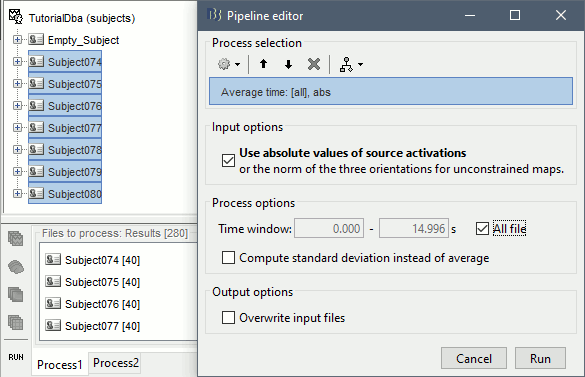
The option Use absolute values of source activations also "flattened" the source maps. The regions that had a few regions with "unconstrained" source orientations, with three values per grid point. These three orientations were grouped into one value by taking the norm along the three axes: sqrt(x2+y2+z2).
- In Process2, select FilesA=Subject74/YF (eyes closed) and FilesB=Subject74/YO (eyes open). Then enter "avg" in the Filter box, to select only the time averages. You should have 20 files selected on each side.
Run the process Test > Permutation test (independent), as configured as below:
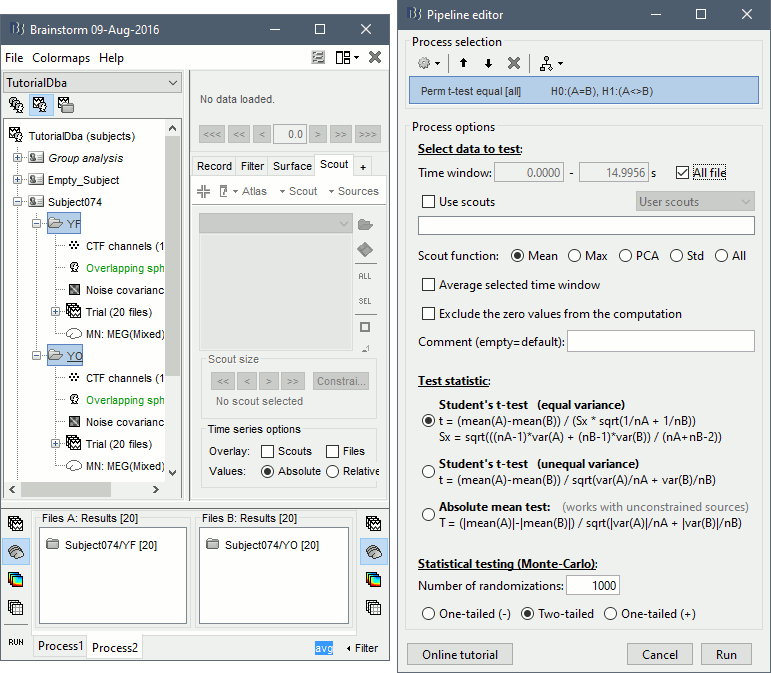
The statistical result can be displayed similarly to the source files, and you can edit the statistical threshold in the Stat tab. Red values indicate that the power in the alpha band is significantly higher in condition YF (eyes closed). As expected, that parieto-occipital regions appear clearly in this contrast.
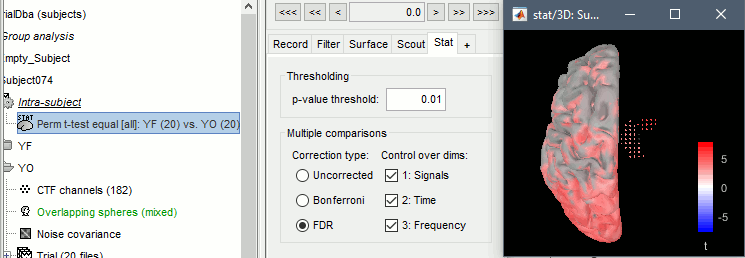
Volume scouts [TODO]
Some subcortical structures are modeled as volume source structures (for instance here, the thalamus and the amygdala). It is not possible to display scouts time series for these structures from the "Source model" or "Structures" atlases. It is necessary to create a new atlas, specific to volume scouts. The steps are the following :
- Second, to create a new scout :
Click on the "Create scout" cross, and click one point of the structure you want to include in the scout
Click on the "Increase scout size" as many times as necessary to include all the points of the volume, for example in the right thalamus
- Repeat this operation for all the volume scouts you want to create
References
Attal Y, Bhattacharjee M, Yelnik J, Cottereau B, Lefèvre J, Okada Y, Bardinet E, Chupin M, Baillet S (2009)
Modelling and detecting deep brain activity with MEG and EEG
IRBM, 30(3):133-138
Attal Y, Schwartz D (2013)
Assessment of Subcortical Source Localization Using Deep Brain Activity Imaging Model with Minimum Norm Operators: A MEG Study
PLOS ONE, 8(3):e59856
Dumas T, Dubal S, Attal Y, Chupin M, Jouvent R (2013)
MEG Evidence for Dynamic Amygdala Modulations by Gaze and Facial Emotions
PLOS ONE, 8(9): e74145
